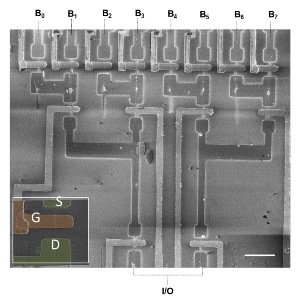Aug 1 2013
Researchers working with tiny components in nanoelectronics face a challenge similar to that of parents of small children: teaching them to manage on their own. The nano-components are so small that arranging them with external tools is impossible. The only solution is to create conditions in which they can be “trusted” to assemble themselves.
 SEM image of a logic circuit based on 14 nanowires
SEM image of a logic circuit based on 14 nanowires
Much effort has gone into facilitating the self-assembly of semiconductors, the basic building blocks of electronics, but until recently, success has been limited. Scientists had developed methods for growing semiconductor nanowires vertically on a surface, but the resultant structures were short and disorganized. After growing, such nanowires need to be “harvested” and aligned horizontally; since such placement is random, scientists need to determine their location and only then integrate them into electric circuits.
A team led by Prof. Ernesto Joselevich of the Weizmann Institute’s Materials and Interfaces Department has managed to overcome these limitations. For the first time, the scientists have created self-integrating nanowires whose position, length and direction can be fully controlled.
The achievement, reported this week in the Proceedings of the National Academy of Sciences (PNAS), USA, was based on a method developed by Joselevich two years ago for growing nanowires horizontally in an orderly manner. In the present study – conducted by Joselevich with Dr. Mark Schvartzman and David Tsivion of his lab, and Olga Raslin and Dr. Diana Mahalu of the Physics of Condensed Matter Department – the scientists went further, creating self-integrated electronic circuits from the nanowires.
First, the scientists prepared a surface with tiny, atom-sized grooves and then added to the middle of the grooves catalyst particles that served as nuclei for the growth of nanowires. This setup defined the position, length and direction of the nanowires. They then succeeded in creating a transistor from each nanowire on the surface, producing hundreds of such transistors simultaneously. The nanowires were also used to create a more complex electronic component – a functioning logic circuit called an Address Decoder, an essential constituent of computers. These ideas and findings have earned Joselevich a prestigious European Research Council Advanced Grant.
“Our method makes it possible, for the first time, to determine the arrangement of the nanowires in advance to suit the desired electronic circuit,” Joselevich explains. The ability to efficiently produce circuits from self-integrating semiconductors opens the door to a variety of technological applications, including the development of improved LED devices, lasers and solar cells.